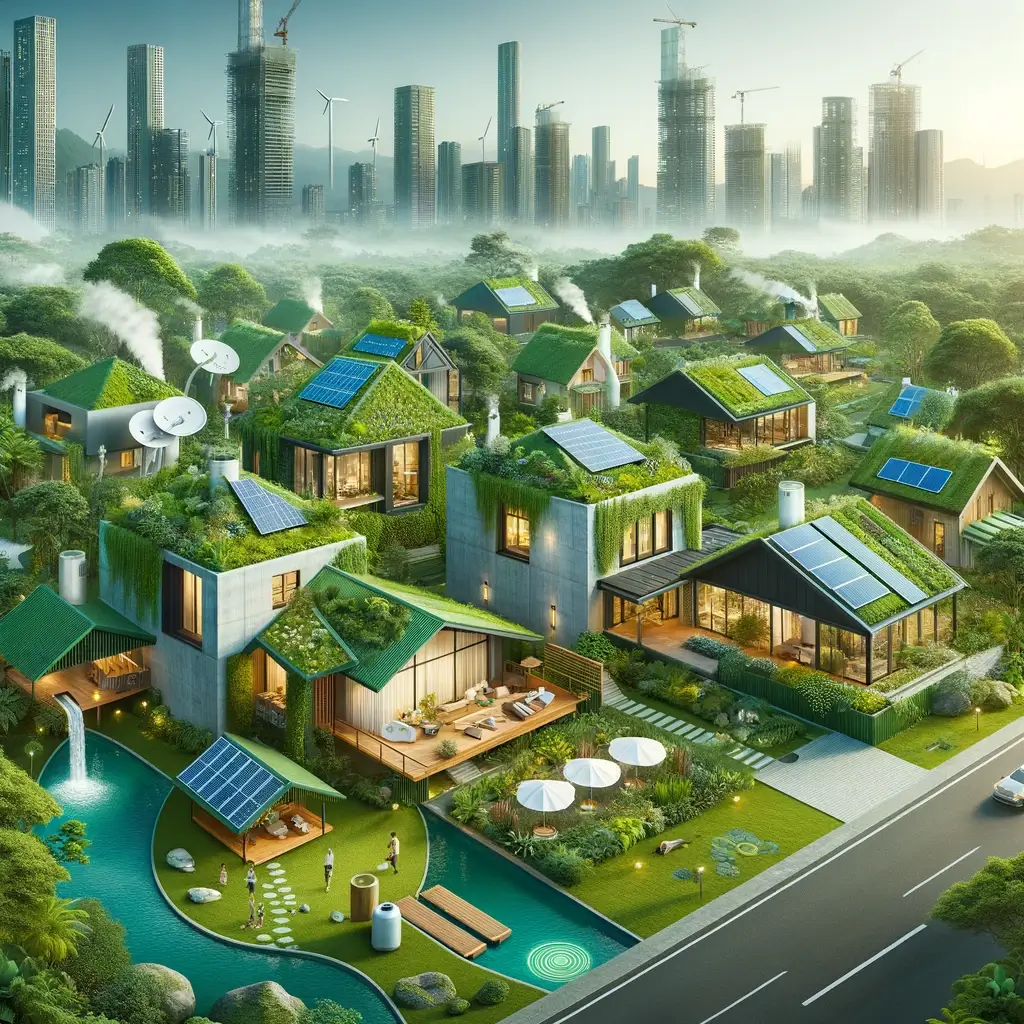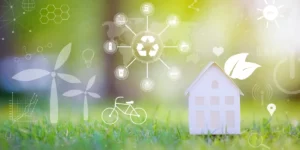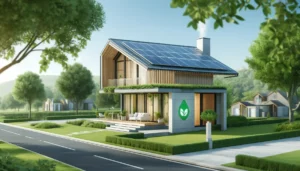Environmental awareness is growing, driving a profound transformation in the construction industry. Today, builders and buyers are turning to eco-friendly solutions to reduce their homes' environmental footprint while improving their quality of life. Eco-friendly homes are emerging as an innovative and essential solution to the environmental challenges of our time.
These homes are designed to coexist harmoniously with their surroundings. They use sustainable materials, energy-efficient technologies, and efficient resource management systems, minimizing their carbon footprint. The goal is clear: to provide a healthy and pleasant living environment while conserving natural resources for the future.
For those who want to adopt this sustainable lifestyle without compromising their budget, our platform offers a convenient solution. Discover affordable eco-friendly homes with our dedicated search tool, which allows you to filter and select eco-friendly models suited to your needs and budget. Explore a variety of options and find your future eco-friendly home. here.
What is an ecological house?
An eco-friendly home is characterized by its design and management focused on sustainability and efficiency, with the primary goal of minimizing its impact on the environment. This type of housing goes beyond simply using eco-friendly building materials; it encompasses a holistic approach to housing, integrating intelligent design principles and advanced technologies to maximize energy efficiency and minimize waste.
At the heart of ecological architecture is the use of sustainable and renewable materials. These materials are chosen for their low environmental impact, whether in terms of extraction, production, transportation, or recycling capacity. Wood from sustainably managed forests, locally produced clay bricks, or insulation made from recycled materials are just a few examples of the materials favored in ecological construction.
In short, an ecological house is above all a home designed to respect the environment and reduce energy consumption. Here are the key points that characterize this type of habitat :
- Sustainable Materials: Use of certified wood, local clay bricks and recycled insulation to minimize the environmental impact of construction.
- Energy Efficiency: Design optimized to take advantage of the sun's light and heat, reducing the need for heating and artificial lighting. This includes well-insulated windows and natural ventilation systems.
- Renewable Energy: Installing solar panels or wind turbines to generate clean electricity. Some homes also use geothermal heat pumps for heating and cooling.
- Water Management: Rainwater harvesting systems and greywater reuse for toilets and garden watering, to reduce drinking water consumption.
Eco-friendly homes improve their energy efficiency by leveraging renewable energy sources (such as solar, wind, and geothermal), employing advanced insulation, high-efficiency windows, and ventilation systems that harness natural air to reduce energy needs.
These homes adopt technologies such as solar panels and heat pumps to ensure environmentally friendly energy management. To save water, they use rainwater harvesting and graywater recycling systems, thus reducing dependence on potable water.
Principles of an ecological house
The fundamental principles of an eco-friendly home revolve around sustainability and efficiency, aiming to create a healthy and environmentally friendly living space. Here are the 5 principles or pillars on which the design of a eco-friendly house :
1. Reduction of carbon footprint
The goal is to minimize the environmental impact of the house throughout its lifetime, from construction to daily use. For example, using local materials reduces transportation emissions, while solar panels reduce dependence on fossil fuels.
2. Conservation of energy
Eco-friendly homes are designed to be extremely energy efficient. This includes superior thermal insulation, which keeps the home warm in winter and cool in summer, reducing the need for heating and cooling. The home's orientation is also designed to maximize sun exposure in winter and minimize overheating in summer.
3. Use of non-toxic materials
To ensure a healthy indoor environment, eco-friendly homes prioritize non-toxic and environmentally friendly building and finishing materials. This includes low-VOC (volatile organic compound) paints, certified wood or recycled flooring, and natural fiber insulation.
4. Efficient water management
Water harvesting and rational use are central to the principles of ecological housing. Rainwater harvesting systems for irrigation or sanitation, as well as graywater treatment systems for reuse in the garden, illustrate this commitment to preserving this precious resource.
5. Integration into the environment
An eco-friendly home must blend harmoniously with its natural environment. This may involve preserving existing trees on the property, creating green roofs that promote biodiversity, or designing gardens using native plants that require less water.
In short, the principles of an eco-friendly home aim to create a sustainable habitat that respects the environment and provides a healthy and pleasant living environment for its inhabitants. These principles are embodied in judicious choices in design, materials, and technologies, illustrating a commitment to a greener planet.
Budget to plan for an ecological house
Transitioning to an eco-friendly home is an investment in a sustainable future, but how big is that investment? Comparing the initial costs of building or renovating a home to make it eco-friendly with those of traditional construction helps us understand the importance of long-term investments.
Construction and Renovation Costs
The cost of an eco-friendly home can vary depending on several factors, such as the size of the home, the materials used, and the desired level of durability and energy efficiency. On average, an eco-friendly home costs about $6 billion more than a conventional home. This puts the average cost of an eco-friendly home in Quebec at around $355,000, compared to $335,000 for a traditional home.
Building an eco-friendly home in Quebec varies widely in cost, influenced by the size of the home, the green technologies incorporated, and the desired level of sustainability. According to the article "How much does an eco-friendly home cost in Quebec?" on the websiteEco-housing, the average cost of an eco-friendly home can range from $200 to $500 per square foot, which excludes land costs, excavation, utility hookups, and landscaping.
Traditional homes cost less initially; however, eco-friendly homes offer substantial long-term operating cost savings through improved energy efficiency and lower energy bills. It's also important to note that renovation costs to make a home more eco-friendly can be similar to those of traditional renovations, but with the added benefit of reducing your carbon footprint and future energy costs.
Financial Aid and Grants
Fortunately, Quebec offers various financial aid, grants, and tax credits to encourage green construction and sustainable renovations. For example, the RénoVert program offers a tax credit for eco-friendly home renovations.
Additionally, programs such as Novoclimat 2.0 encourage the construction of new, energy-efficient homes by offering attractive grants. These financial incentives are designed to reduce upfront costs and accelerate the return on investment for homeowners.
Check out our resources to help you with your green home financing: Eco-friendly home grants: Towards greener homes
Is it a good investment?
Investing in an eco-friendly home certainly requires a higher initial budget, but the long-term benefits, both financial and environmental, justify the investment.
With the help of available grants and tax credits, as well as future energy savings, opting for an eco-friendly home becomes an economically viable and environmentally responsible decision.
What are the benefits of an eco-friendly home?
Transitioning to an eco-friendly home brings a multitude of benefits, ranging from protecting our environment to tangible economic benefits, not to mention improving the health and well-being of residents.
Here's a detailed exploration of these benefits:
Environmental Benefits
- Reduction of Greenhouse Gas Emissions: Eco-friendly homes, thanks to their efficient use of energy and reduced dependence on fossil fuels, emit fewer greenhouse gases. Adopting renewable energy sources, such as solar and wind, directly contributes to reducing our overall carbon footprint.
- Conservation of Natural Resources: By using sustainable and renewable materials, eco-friendly homes minimize the use of natural resources. This includes using certified wood, recycled materials, and reducing water consumption through rainwater harvesting and graywater treatment systems.
- Protection of Biodiversity: By reducing deforestation, pollution, and using land more responsibly, eco-friendly homes help protect natural habitats and maintain biodiversity.
Long-Term Economic Benefits
- Savings on Energy Bills: The energy efficiency of eco-friendly homes means less energy waste and, consequently, substantial savings on electricity and heating bills. Passive solar design, superior insulation, and efficient heating and cooling systems reduce the need for external energy.
- Property Valuation: Eco-friendly homes tend to have higher resale value due to their sustainable features and the increasing demand for environmentally friendly housing. This makes them a wise long-term investment.
Health and Quality of Life Benefits
- Improving Indoor Air Quality: Through the use of non-toxic materials and improved ventilation, eco-friendly homes provide better indoor air quality, reducing the risk of allergies, asthma, and other health problems.
- Thermal Comfort: Excellent insulation and efficient temperature management ensure year-round indoor comfort with fewer temperature and humidity fluctuations.
- Connection with Nature: Designs that include green spaces, green roofs, and harmonious integration with the outdoor environment promote psychological and physical well-being, strengthening residents' connection with nature.
In short, investing in an eco-friendly home is a smart decision that not only benefits the environment and the economy, but also enhances individuals' health and quality of life. These benefits, combined, make eco-friendly homes an essential choice for those who aspire to a sustainable and responsible lifestyle.
What are the disadvantages of an eco-friendly house?
While eco-friendly homes offer many benefits, they also come with some challenges and drawbacks that are important to consider. An honest assessment of these aspects can help future homeowners make informed decisions and plan effectively.
High Initial Cost
The first obstacle many face is the high initial cost of building or renovating to achieve eco-friendly standards. Incorporating green technologies, such as solar panels, rainwater harvesting systems, or advanced thermal insulation, can significantly increase initial costs.
Suggestions: To overcome this obstacle, it is recommended to look for subsidies, financial aid, or tax credits offered by local or national governments. Moreover, it is important to view these costs as long-term investments that will result in energy and money savings in the future.
Availability of Materials and Technologies
In some regions, access to green building materials and sustainable technologies may be limited. This can make building an eco-friendly home more complex and potentially more expensive due to transportation costs and the importation of these materials and technologies.
Suggestions: One solution is to prioritize the use of local materials and traditional construction techniques adapted to the local climate and environment. This not only reduces the carbon footprint associated with transportation but also boosts the local economy.
Complexity of Design and Construction
Designing and building an eco-friendly home requires specific expertise to optimize energy efficiency and integrate sustainable systems. Finding architects and builders with the necessary experience can be challenging.
Suggestions: Consult green building experts early in the project. Their expertise can guide design choices and ensure the home meets the desired ecological standards. It's also helpful to consult professional associations specializing in sustainable construction for recommendations.
Maintenance and Technology
Some eco-friendly technologies may require more regular maintenance or specific knowledge for optimal operation. This can be a disadvantage for owners less familiar with these systems.
Suggestions: Before committing to installing specific technologies, it's important to research their maintenance requirements and the ease of access to qualified repair services. Training and education on the operation and maintenance of these systems can also reduce inconvenience.
In conclusion, while building or renovating an eco-friendly home presents challenges, most of these obstacles can be overcome with proper planning, thorough research, and leveraging available resources. A commitment to sustainable living brings long-term benefits that far outweigh any initial drawbacks.
Conclusion
In conclusion, ecological houses represent a revolutionary approach to housing, combining respect for the environment, energy efficiency and improved quality of life.
Although their implementation may present initial challenges, such as higher costs and the need for specialized expertise, the long-term benefits in terms of energy savings, reduced carbon footprint and improved well-being are undeniable.
Available financial aid and grants can mitigate the financial impact, making investing in ecology not only viable but also beneficial in the long run.
As society moves towards increased environmental awareness, eco-friendly homes are positioning themselves as a key solution for a sustainable future.


